Tamron Blogs
More Photo Tips | Video Gallery | Photo Gallery | Enewsletter sign-up
Tamron On Safari
By David and Henry Schloss
Photographs by Henry Schloss (except where indicated)
This year our family went to Botswana on safari, and my son Henry, who is 11 and an aspiring wildlife photographer, brought the Sony Alpha 7C and the Tamron 70-300mm F/4.5-6.3 Di III RXD.
This is an exceptional lens for a safari for several reasons. The 70-300 is an incredibly compact, versatile lens with a range of focal lengths that would typically only be achieved with two or more lenses.
The 70-300mm F4.5-6.3 Di III is also lightweight and very compact—an important consideration when traveling on a safari as there are weight limitations on the small planes and helicopters used for transport between camps.
For anyone on safari (especially for my 11-year-old son, the weight and size of the lens are perfect for handheld shots, the only option when traveling in the back of a Land Cruiser. A typical day would see three or more hours of driving while looking for animals and then rely on quick reflexes to capture an animal darting through the bush.
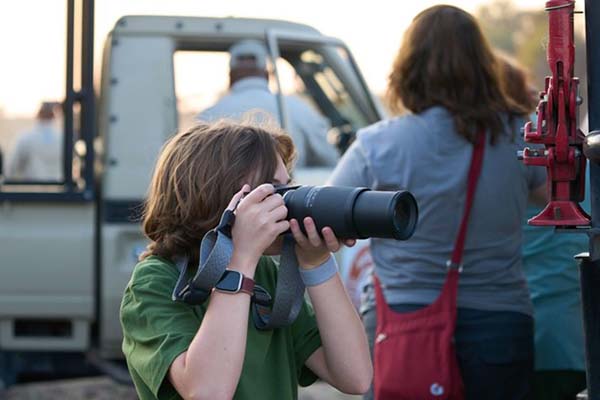
Autofocus on the lens is superb, and the image quality is tack-sharp. The relatively-fast F4.5-6.3 aperture allows for good low-light photography while blurring backgrounds at long focal lengths. When reviewing the 2000 images Henry captured during the week-long trip, almost all are in focus.
Here are some of my son’s favorite images and some of his tips for safari photography.
Get Close Then Get Closer
“The secret to wildlife photography,” my son jokingly explains, “is to get close to the animals and take their picture.” There are several ways to get close to an animal on safari. The first is to get physically close—something possible when your guides know the animals and how to approach them. Most animals (we are told) just see the Land Cruisers as a noisy shape that doesn’t try to hurt them, allowing the guides to get very close. Many of the animals will just ignore the safari vehicles.
Of course, these are wild animals in their natural habitat. Even a quiet human is intruding, so the best way to get close is with a long telephoto lens. A 300mm lens is not the longest focal length we saw on this safari, but it was the most practical. One photographer from a different group had a DSLR with a 500mm lens, and the lens was massive. It was hard for him to maneuver the setup in his vehicle. At the same time, Henry could quickly move around and get a good angle on anything that caught his eye.
We came across this stunning female leopard at the end of the last day of the safari. We had driven for about 45 minutes following a road the guides thought would be a good spot for a possible encounter with big cats. As dusk approached, we set out, hoping to see a big cat since they are more active as the heat of the African sun abates. We saw a massive bull [male] elephant blocking the road and looking at us menacingly. During mating season, the males can become quite aggressive, so we quietly backed up and drove off.
Five minutes later, our guide said, “there’s a leopard in that tree.” Also traveling in our van was a family and the six-year-old girl in the family said, “no, there’s two in that tree.” This female leopard was at the top of the tree while her mate slumbered on a branch below.
After sunning themselves for another ten minutes while we watched, the pair climbed out of the tree and walked toward a glade. It was mating season, so the male and female traveled together, and we could keep an eye on both. My son had been in a different truck that night, and the guides somehow managed to give good enough directions that his vehicle could find ours in the middle of a clump of trees and brush as the sun set.
They took up a position close to the leopardess as she sat in a cozy spot in the tall grass. He took many shots of the leopard from this angle, which I could not capture due to our position. The large (for a telephoto) aperture allowed him to get quite a bit of light still on the leopard’s face for this shot. A few moments later, the sun dropped behind the treeline, and the light was so low the resulting photos are grainy (but still useable with a bit of Photoshop mojo.)
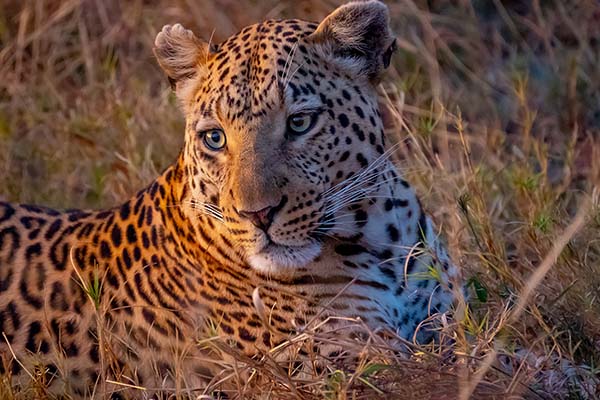
300mm, f/6.3, 1/30 sec., ISO 12800
Click image to view larger
Create A Moment, Not A Checklist
An all-too-common practice on a safari is to list animals you want to capture and photograph them like ticking off boxes on a checklist. Here’s a lion. Here’s a wildebeest, here’s a giraffe. Some photographers are so excited to see an actual wild animal in the wild that they don’t give much thought to lighting or composition. The setting sunlight on the leopard makes this not just a snapshot.
Since most of the day, the sun is directly overhead and very harsh, many photos of animals look flat and washed out. Even the most magnificent creatures can end up unflattering and losing the feeling of being in the wild.
That being said, by all means, capture images of any animal you’re interested in, even if the scene isn’t flattering. It’s better to have a photo of a giraffe partially obscured by trees than to have no picture of a giraffe. Remember to work on composition and lighting after you’ve “bagged” the animal.
My son and I have about 50 versions of this photo, none of which are captivating images. This was the first lion we saw. The lighting is awful, the setting makes for a horrible composition, and there’s nothing unique about this shot.
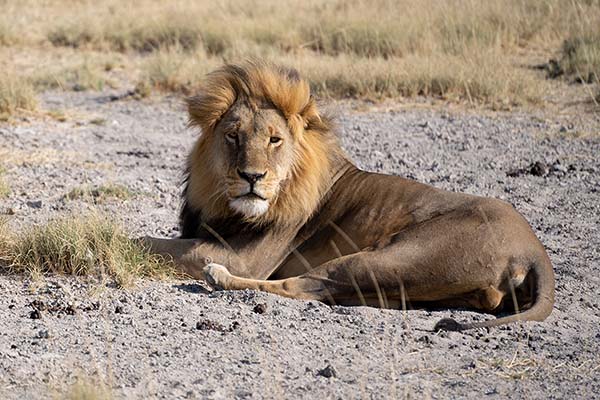
300mm, f/6.3, 1/800 sec., ISO 200
Click image to view larger
Stick around long enough, and something magical will happen.
Lionesses do the hunting; usually, the male lions leave them to it. But as we were there during mating season, this male kept following two females around, barging in when they were otherwise occupied. On this day, they were lying in wait as a group of wildebeest and zebras passed by them. It was the perfect ambush, the kind you see on National Geographic or in a documentary narrated by David Attenborough.
The two lionesses were blending in with the tall grass alongside a watering hole, their noses up as they smelled the air. Wildebeest and zebra travel together in often massive groups. Wildebeest like that zebra have a better view, and if a zebra takes off running from a predator, they’ll all run away. Zebras like the company of wildebeest because they can run faster than wildebeest, which makes these companions fur-covered shields.
Just as the prey edged closer to the lionesses, this young male got up to investigate the action, with the predictable result of ruining the hunt. The zebra saw him coming and started to run away, kicking up dust, and the wildebeest followed suit.
In Henry’s photo, you can see the lion sauntering over as the animals scatter and one of the lionesses making a last-ditch effort to catch some lunch.
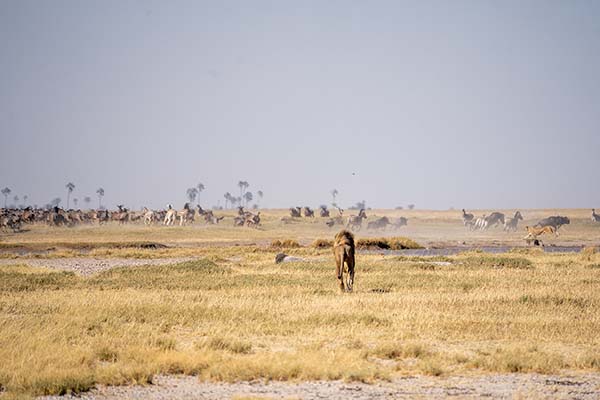
300mm, f/6.3, 1/1000 sec., ISO 200
Click image to view larger
This is a wider angle version that shows the animals' dust trail and the lion's nonchalance. The cropped image shows the lioness trying to salvage the ruined hunt.
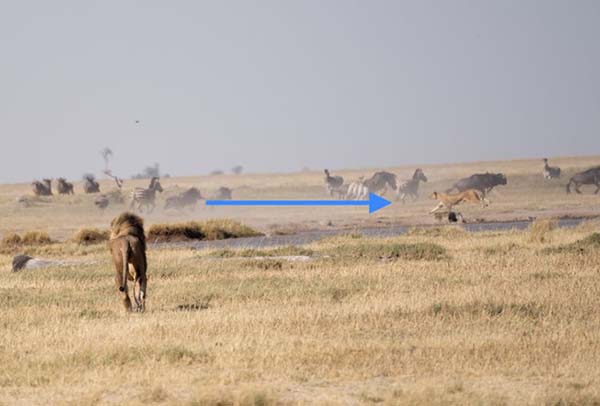
Thanks to the optics in the Tamron 70-300mm F/4.5-6.3 Di III RXD, the lioness is clearly visible despite the distance and the haze. With a fast shutter speed, it captured the panic of the prey as they sprinted away.
“Arrive early, stay late,” my professional photographer father always said. So we held our spot near the closer (to us) side of the watering hole. Several of the safari trucks pulled away after this. With a ruined hunt, there didn’t seem to be much left to photograph.
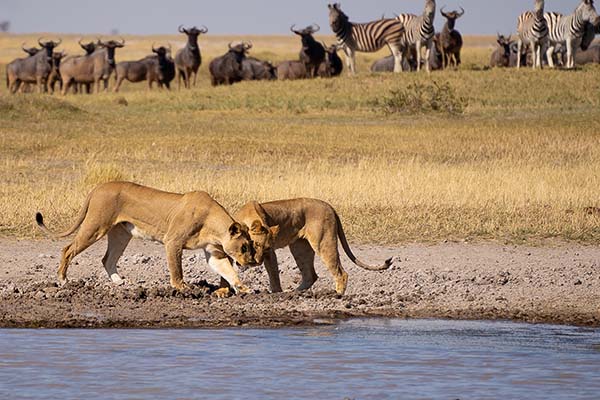
300mm, f/6.3, 1/1000 sec., ISO 200
Click image to view larger
That’s when the two lionesses—a mother on the left and her daughter on the right—circled around to the watering hole, taking a few minutes to nuzzle each other.
This is one of my favorite images Henry captured. It shows the love these mighty cats have for each other while also showing how the nervous wildebeest and zebra keep a wary eye on them. Henry has the entire interaction from lionesses coming together through a few minutes of head rubbing later. Two utterly different life experiences in the delta between cats and cattle.
Elephants
Botswana has a huge elephant population because elephants aren’t hunted in Botswana. Several of the neighboring countries hunt elephants. So the elephants migrated, and most seem to be in Botswana. It’s hard to not see them. We were trapped inside our cabin at one of the camps for hours while a herd of elephants noisily ate the trees outside our windows.
Elephants only sleep a few hours a day and spend the rest of their time eating, drinking, or moving between somewhere to eat or drink. We came across these elephants the first night of the safari after a long drive to camp while we watched the sunset by the river banks as they headed down to drink and wash off.
Elephant skin is very sensitive, so the giant creatures often cover themselves in mud or, as with the elephant here, water.
“I like this photo because I caught the water mid-splash. There was another photo with an elephant splashing itself, but it didn’t look as good because the water wasn’t in the right shape. Here you can see the dynamics of the water.”
The water frozen in mid-air was caught thanks to a shutter speed of 1/320 sec., fast enough to freeze individual droplets but slow enough to provide some smoothness to the stream coming out of the trunk.
It was also essential to get the light right. “The sun was setting,” Henry said, “so I had to wait till they walked into some sunlight. I also like that the light was shining so that the water reflected the elephant.”
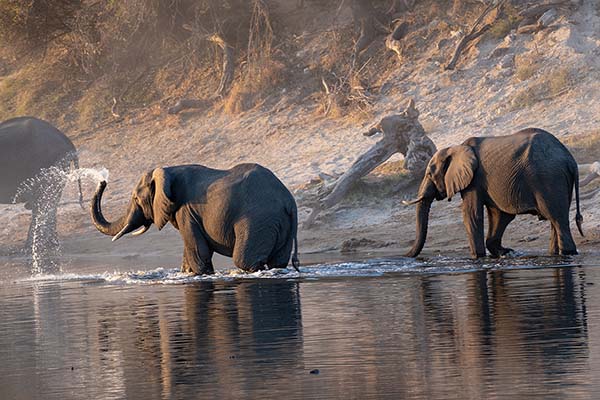
300mm, f/6.3, 1/320sec., ISO 800
Click image to view larger
Blur The Background, Increase The Cuteness
There is no animal in Africa cuter than a meerkat. These inquisitive, adorable animals are the stars of everything from Lion King to the Meerkat Dynasty. This gang of Meerkats (yes, that’s really what a group of Meerkats is called) has been studied by scientists for years, and they have come to trust that humans will not hurt them. “The scientists studied them for so long, they said it would be okay to bring people there,” Henry explains.”If people are [outside the entrance] when they come out in the morning, they’re okay with it.”
As a result of this long-time interaction, they are incredibly calm around people, and it’s possible to spend hours photographing them.
Meerkats start every morning by poking out their burrows and checking the terrain for predators. If humans are around when they are scanning the horizon, they’ll either ignore the people or climb up on them for a better vantage point.
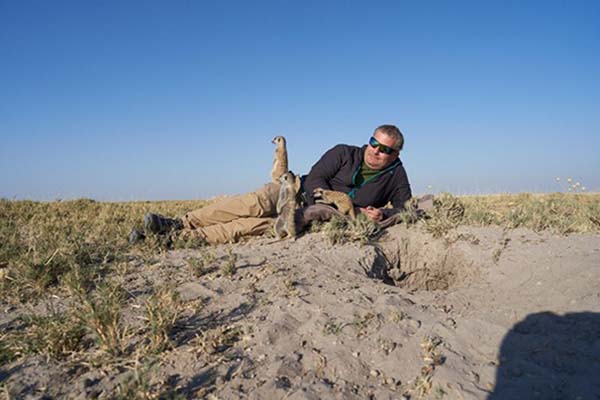
[Photo by Lemme Gust]
Their burrows have as many as 15 entrances, so the guides must figure out which one they’ll be coming out of on a given day. If you get in the right place, you’re treated to some of the cutest interactions on the continent.
“We were close here, like five feet away,” Henry explained, “and there were people all around.” The background blur from shooting this wide open gives a feeling of depth to the photo and helps obscure some of the distractions in the background. The darkness in the top left corner (which Henry cropped in the final image) is the tire from one of the vehicles. Still, the bokeh renders it soft and looks like a vignette.
While the Meerkats spend time looking around before they leave their burrows to forage for bugs, they rarely look right at a person as they are scanning the horizon in the distance. Getting this shot required patience and a lot of time tracking while in animal-eye-detect to get this head-on shot.
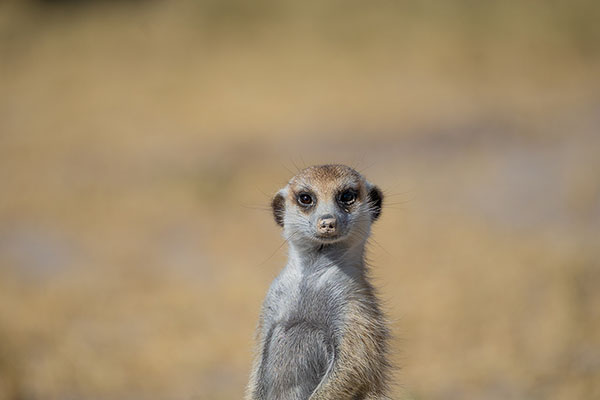
300mm, f/6.3, 1/2000 sec., ISO 200
Click image to view larger
Be Vigilant
Hyenas have a terrible reputation. They’re most often portrayed in books and movies as deceptive scavengers, sometimes working as a gang of enforcers for an evil lion antagonist.
In reality, they’re social pack animals with a very tight hierarchy. While they look like dogs, they’re in the same order but in a different family. The spotted hyena (also known as the laughing hyena) is in the genus Crocuta, while the brown hyena is in the genus parahyaena and is the last remaining species of this genus.
We are told by the guides that most animals don’t even really see the trucks. Unless a passenger sticks their head past the edge of the open-sided trucks or moves around quickly in the vehicle, the animals simply see a silhouette and know they aren’t at risk.
Only a few animals on the whole were clearly looking at the passengers inside the vehicles—elephants and the groups of hyenas we encountered. “The hyenas, they definitely know there are people there,” said Henry. One group of spotted hyenas came over to investigate our truck, sniff the air, and made eye contact as they evaluated the passengers.
This brown hyena pup peeks out to look at us as the sun sets on the salt pans of the Kalahari, and it is keenly aware that we are not just a truck. The pups will usually stay in their den while their mother hunts, but as they get older, they start to venture out on their own. “Another truck pulled up and scared the pup, we had to wait a while until this pup came out again.”
Henry sat at the ready with both hands on the camera and the lens already focused where we had the first quick siting of the pup.
This curious pup checked us out long enough to make sure we weren’t a threat and then wandered off with its sibling in search of food—a sign that this pup was almost old enough to no longer need the care of its mother. As the light dropped to a level too low for photography a sibling joined it and they walked off together, stopping once to play with an old bone.
Finding this hyena was no simple task, at least not for the guides. It takes a lot of patience and expert tracking to find a den of brown hyena pups and a lot of familiarity with the terrain to navigate back to them.
Since so many images on safari are taken at dawn or dusk, having a lens with a wide aperture even at the long end of the telephoto range allows for shots that other systems can’t get, such as this adorable fuzzy pup waiting to go out for one of its first forages without its mother. Like with all of the shots on this safari, the Tamron 70-300mm F/4.5-6.3 Di III RXD is the perfect choice for the task.
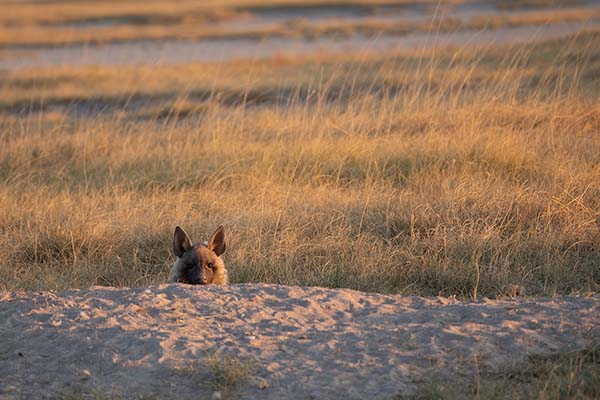
300mm, f/6.3, 1/100 sec., ISO 200
Click image to view larger
More Photo Tips | Watch Videos | Learn More About Tamron Lenses | Photo Gallery